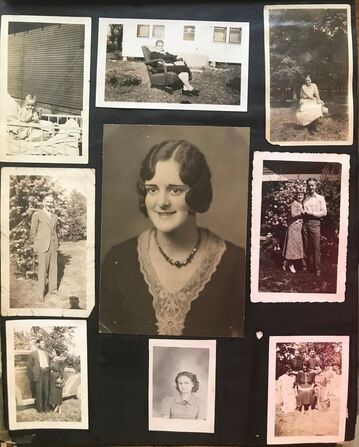Dear Davina,
How do I....? What should I...? What is the best way...? Ask our expert for answers!
Take a look at some of our articles from past contributors:
What Should I Keep?
From an Archivist point of view... By University of Michigan archivist, Colleen Marquis. She is a professional with almost ten years worth of experience in document preservation and works at the Genesee Historical Collections Center at the University of Michigan - Flint. When I first started down the archival path, they told me, “your job isn’t to keep everything, it’s to decide what to throw away.” A long time ago, archivists strived to keep nearly everything, but today a theoretical retention of 10% of a donation is bandied about. Theoretical being the operative word. In practice, it’s quite another story and it depends on the institution and the collection. That might be reasonable for a corporate archive when you’re talking redundancy after redundancy but the number is much higher in local history collections. Generally, medium-sized local history archives, such as University of Michigan-Flint, keep closer to 50-100% depending on what comes through the door. Archivists also theorized, at the dawn of the computer age, that document load would gradually decrease as ones and zeros replaced typewriters and mimeographs. We were wrong. So incredibly wrong. Humanity produces more paper records now than ever before in our history, and the computer has only added to the avalanche by making printing accessible while the digital medium remains impermanent and unreliable. As Google’s recent shut down showed us, everything stored digitally can be wiped away in an instance. We are one good sunburst away to be thrown back into the 1970s. So how does that translate to what should you keep? When I go through a collection, I eliminate all mass market published items first. Are you keeping that newspaper from the Kennedy assassination or the last time the Tiger’s won the World Series? First thing to go. Why? Well a few reasons:
With those out of the way, look for duplicates. I will keep 2-3 copies of small items, 1-2 of big items, but anything over that will be added to the return pile. Receipts seem like historical records, but a printed quarterly or even yearly budget will do the same thing with less fuss. Things you should absolutely keep include personal journals, letters, fliers/handouts, meeting minutes/notes from organizations you are involved with, and photographs with meaningful information like date, location, and the names of any people photographed attached. If you have photographs that no longer have any hope of ever being identified do not feel like you need to keep them. It’s sad but they take up valuable space and have little historic value. Personally, I culled over three dozen photos of birthday cakes from my family's photograph collection. If you think who would keep stuff like that? I’ve had people try to donate their drawings from kindergarten. I recently saw a medical device for incontinence from the late 60s donated to a repository. I’m trying to say there is a difference between items of historic importance, family keepsakes...and trash. HOW DO I TAKE CARE OF MY FAMILY PHOTOS?
By University of Michigan archivist, Colleen Marquis. She is a professional with almost ten years worth of experience in document preservation and works at the Genesee Historical Collections Center at the University of Michigan - Flint.
Photos, like all documents, should be kept at a cool and constant temperature. Extreme fluctuations in temperature adds stress to the medium your photos are printed on and can lead to cracks and peeling on the surface. Keep items cool, not cold, as extreme cold can actually do more harm than good. Make sure they are stored somewhere dry. Again, consistency is important when it comes to humidity. For example basements and attics are terrible places for photographs, but that is one of the most common places to find hordes of them! Photos should be individually sleeved in archival sleeves, or at least somehow separated from each other, using an acid and lignin free paper. If the paper the photo is touching is acidic the photo will discolor over time. The benefit of a plastic sleeve is it keeps the photo, front and back, viewable while also safe to handle with bare hands. For older photos or different formats, like daguerreotype or tintype images, you may want to consider an opaque enclosure to further prevent any accidental light exposure. Do not over wrap your photographs. You may think the more hermetically sealed the better but this is not true! As paper breaks down it produces a variety of gases that can speed up decay. Definitely do not laminate anything! Leave a vent for gas to escape in any enclosure you use. This goes for outer housing as well. Do not store photos in sealed buckets or containers as that will trap the gasses. Curled photos? You can actually gently and slowly humidify photographs to aid in flattening. First make sure the photos are clean, use a clean medium weight brush to remove any stuck on dirt or grime. To humidify curled photos, I use a clear rubbermaid container with a lid, a cooling rack for baked goods, and enough distilled water to just cover the bottom of the container. Put the small amount of water into the container and set the cooling rack inside - only the feet of the cooling rack should be touching the water. Then place photos on the rack (not directly in the water!) and seal the box for an hour or two. Do not go over four hours as you increase the risk of mold growth. For most photos you will see them relax pretty quickly. Remove from the humidifier as soon as you notice the photos uncurling. Place them between parchment paper or freezer paper to protect them and press under heavy books for a couple of days. Voila, flat photos! This method also works wonderfully for documents, maps, posters - anything that has been rolled up for years and years. Old photo albums? If photos are loose in an old paper album see if you can remove them safely. Most paper photo albums from the past are made of extremely cheap, damaging paper. If you are lucky, many old glues dry out and the photos will easily pop off. Sometimes photo holders were used and that also makes removing photos easy. For more modern photo albums remove photos if the album does not adequately provide for ventilation or uses some kind of adhesive backing. If you cannot remove the photos safely do not force it. It is better to wait a few decades to see if the glue dries out further than risk ripping a photo. Simply keep the album clean, cool, and dry. If you digitize your photos make sure to scan at least 300 dpi (dots per inch) and save the files in a couple of different places to ensure that if one system fails you have a back up. I typically have two copies in a cloud storage system and two hard copies saved to two different drives. Be sure to include as much information with the file as possible - names, dates, and locations are crucial to historic photographs. A Seasonal Doldrum: Storing Your Classic Car
By Michael G. Thodoroff
A retired engineer of 40 years at General Motors, Mike raced motorcycles and cars at Clio's Auto City Speedway and cars at Owosso Speedway for 10 years. He is also a former Chief of Technical Inspection for the Sno Drift rally car competition and Formula SAE official for 25 years. Mike also serves as a staff member and docent for Flint's Factory One, and is a board member of the Genesee County Historical Society. The Genesee County Historical Society is surrounded by classic car buffs and car buffs in general, so we conducted an informal survey of various car aficionados regarding the proper way to store a vehicle for the extended cold months. What we first uncovered is there is no one “recipe” to store a vehicle for extended lengths. A majority of the input was based on many years of practical experience but, there were some recommendations that seemed to be based on “wives’ tales!” The following is a general consensus of steps to take to ensure your vehicle will “awake” with no after-effects come springtime.
Here's looking forward to the brighter days of spring – and I don’t mean daylight savings time! Caring for Your Vinyl Records
By University of Michigan archivist, Colleen Marquis. She is a professional with almost ten years worth of experience in document preservation and works at the Genesee Historical Collections Center at the University of Michigan - Flint.
VINYL records have made a surprising comeback in the last few decades. Hipsters, audiophiles, and general geeks/fans love to buy vinyl records, new and old, 45s and 78s, across genres. I was lucky enough as a teenager for my father to give me his old record collection which included the first press of every Beatles album ever produced and more Prog Rock than I’m willing to admit (I spent a lot of time in the Court of the Crimson King as a teenager). But how do you keep your vinyl fresh, usable, and well preserved? Well, this will come as no shock to you but I recommend cool (not cold!) dry storage conditions. Warping caused by humidity, heat, or dramatic changes in temperature can make your records unplayable, and super cold temperatures make them brittle and prone to cracks. There are methods to unwarp records, but an ounce of prevention is worth a pound of cure. Unwarping records, which involves slowly warming the vinyl, is tricky, and you are just likely to ruin the record as help with the warp - especially if you aren’t a professional. Another way records warp is by stacking them. Vinyl records should ALWAYS be stored horizontally. Vinyl records are HEAVY, as anyone who has had to move a robust collection up and downstairs will tell you, and the weight of vinyl on vinyl can push the records into funky shapes over time. Vinyl records should be stored as upright as possible with no angles. Speaking of weight, make sure you store them somewhere that can handle that heft and use smaller boxes that are easier to lift. You also want to store the records off the floor (in case of flooding) and I strongly recommend a box with a lid to keep out sunlight, bugs, and dust. Dust and dirt will also destroy your vinyl, especially if you are using paper sleeves. Dust and dirt collect in these sleeves and creates abrasions every time the record is removed and used. If you are a serious collector and player of vinyl records, invest in some polypropylene sleeves. Sure, they are more expensive but they keep dust out much more effectively and are much easier to use (rounded edges/stiffer material makes record access a breeze). Finally cleaning. You should do a cleaning before and after every play with a carbon fiber brush. Run the brush over the record twice, once to discharge the static of the attached dust and once with the inner soft cloth portion of the brush to wipe the dust away. This should be done very gently and it’s a good idea to use gloves. The oils in your hands will destroy the vinyl so, just like with compact disks, do your best to not touch the playable section. If you a record needs a DEEP clean as sometimes is the case with donated or vintage records use this little trick. Carefully coat one side of the record with wood glue (yes, wood glue) avoiding the paper label in the center. Wood glue is so similar to vinyl that it will only stick to dust/debris on the record. Wait for it to dry and then you have the incredibly satisfying job of peeling the wood glue off the record. The second verse is the same as the first, flip, wood glue, wait, peel. The final piece about loving, preserving, and owning vinyl records is how you play them. A Crowsly record player might be $20 bucks at Meijer but the cheap stylus will start breaking down after as little as forty plays (and sounds terrible even with a new stylus). A damaged stylus is going to start skipping and taking chunks out of the records, sometimes so small you don’t notice it until it’s a problem. Archival-level record players are actually not that bad ($300-$500+) when compared to what a DJ spends on professional turntables. Vinyl records are very sturdy and have wonderful longevity. If properly handled, you and your descendants could enjoy these records well into the next few centuries. |
Davina kuh jakobi
Born and raised in New York City, Davina has been working in the field of conservation since the age of 16, and was lucky enough to get an internship with the Museum of Modern Art. Davina attended University of Delaware for her undergrad, where she double majored in Art Conservation and Art History, and minored in Art. She then went on to obtain two masters at University College London, her MA in Principles of Conservation and her MSc in Conservation for Archaeology and Museums. Working in conservation with various institutions throughout Europe (in Portugal, England, Scotland, Greece, the Netherlands, and Germany) over the past decade, she has come to specialize and write papers about various subjects, such as sporting heritage, maritime heritage, and technical research. After completing her MSc dissertation, Davina worked with the Rijksmuseum in the Netherlands, then went to Bremerhaven to work with the German Maritime Museum (Deutsches Schifffahrtsmuseum). Then she returned stateside to work with the Henry Ford Museum in Dearborn. She specializes in conservation, preservation, technical object-based research, and policy creation, and is particularly passionate about outreach and collaboration. She started working with the Whaley Historic House Museum as Executive Director in 2019 and has absolutely fallen in love with Flint. She says, “I am continuously heartened by the sense of community, camaraderie, loyalty, and welcome that I constantly feel here.” Today, Davina is the Manager of Curatorial Affairs at Applewood Estate and Conservator and Collections Preservation Specialist. In 2021, Davina generously stepped into the role of Curator/Archivist for the Society, and has now taken on the extremely important role of Chairman of the Fundraising Committee, formulating a clear strategy to help us continue ‘telling our story’, as well as raising monies, for example, to help with the care and maintenance of the GCHS’s most important asset, the Arches in downtown Flint. |
|
Made possible with support from:
This publication is made possible in part by a grant from Michigan Humanities, an affiliate of the National Endowment for the Humanities. Any views, findings, conclusions or recommendations expressed in this material do not necessarily represent those of the National Endowment for the Humanities or Michigan Humanities.
|
Programs sponsored by the Greater Flint Arts Council Share Art Genesee County Program made possible by the Genesee County Arts Education and Cultural Enrichment Millage funds. Your tax dollars are at work!
And Our Members
|
Genesee County Historical Society
|










